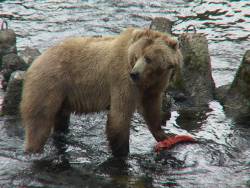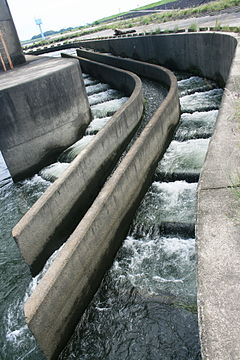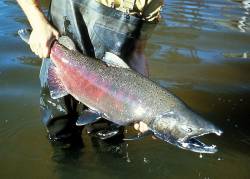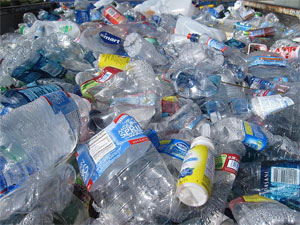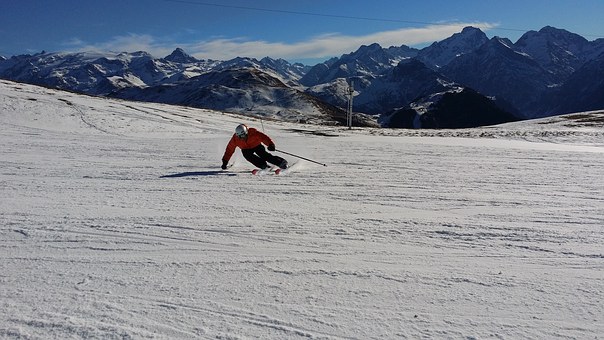In the spring of 2001, Erik Thompson was a senior majoring in Biomedical Engineering at the University of Southern California.
Thousands of Americans have come to rely on dams not only as a source of inexpensive power, but also for irrigation and navigational needs. In spite of their benefits, dams have come under fire because of the role they have played in contributing to the decline of Pacific Northwest salmon populations. To avoid dam removal, engineers have worked to design more fish friendly dams that can continue to produce electricity but minimize the harm done to migrating salmon. This paper provides background on the current controversy over dams and discusses the effects of dams on migratory salmon and the steps engineers are taking to alleviate the problem.
Introduction
The life cycle of a salmon is one of the most unique in all of nature. Young Pacific Northwest salmon face a long, arduous journey as they travel from spawning grounds high in mountain streams, through the Columbia River Basin, and out to the Pacific Ocean. After reaching the ocean, an adult salmon will spend anywhere from two to six years at sea before making the return trip inland to spawn in the same streambeds of their birth.
A Perilous Journey Home
Under the best of circumstances, the journey from a salmon’s spawning grounds to the ocean and back again is a perilous one, and a migrating salmon faces many dangers during the trip. Predatory species such as Pike minnows hungry birds, and Kodiak bears (see Fig. 1) anxiously await any opportunity to feast on the salmon as they pass by. Environmental conditions, such as water temperature and flow rate, can also adversely affect the survival rate of young ocean bound salmon. Returning adults must fight their way upstream, battling the swift currents of rapids and waterfalls, to return to their native spawning grounds. In spite of these hardships, salmon once flourished in the Columbia River.
In the early 1880’s, the advent of commercial fishing marked the first time records of salmon population were regularly kept. At the turn of the nineteenth century, the average number of adult salmon returning to spawn in the Columbia River numbered between 10 and 14 million. During the last century, that number drastically declined, with current returning salmon counts hovering between 1 and 2 million [1]. In 1995, of the nearly 1000 original species of salmon and steelhead, 106 were extinct and 314 were listed as endangered [2].
Many factors account for this drastic decline in the salmon population. Although natural factors such as climate variations do affect salmon populations, most of the decline in population has been attributed to human interference. Human factors are three-fold: 1) population decline as a result of fishing; 2) habitat destruction due to logging, construction, agriculture, and dams; and finally the most significant, 3) destruction and blockage of migratory routes by hydroelectric dams. Dams account for nearly 99% of migratory salmon deaths, and have been the subject of much controversy in recent years [3].
The Whole Dam Problem
Because of the extreme negative impact dams have had on salmon migratory routes, many environmentalists have called for the complete removal of some Pacific Northwest dams. While proponents of dam removal present the solution as an easy and obvious step towards the recovery of salmon, this seemingly simple solution comes with a huge price. Removing dams would indeed help to restore natural salmon habitat, but the destruction of dams would also carry enormous economic and even environmental consequences for the Pacific Northwest.
Hydroelectric dams provide one of the cheapest and cleanest energy sources available today. Electricity produced by hydroelectric dams costs on the average, $10 per megawatt hour to produce. Alternative methods of power production such as nuclear, coal and natural gas plants cost $60, $45, and $25 per megawatt hour of electricity produced respectively. Hydro-power is also relatively clean. Hydro-powered is also relatively clean compared to coal and natural gas power, which release thousands of tons of contaminants into the air annually. Dams are clearly an excellent source of power but their benefits extend beyond cheap electricity. Pacific Northwest dams provide irrigation to over two million acres of farmland. Additionally, they provide navigable waters for the barge transportation of crops [4].
The removal of dams will clearly cause economic havoc, forcing industries that rely on inexpensive electricity to relocate and forcing several farmers into bankruptcy. Dam removal has the potential to also increase air pollution, as the loss of hydropower would require the construction of less-benign power plants. However, the effect of dams on dwindling salmon populations is undeniable. To help resolve this problem, engineers are examining exactly how dams affect migrating salmon and designing solutions which will help ease the passage of the fish.
Adverse Effects on Salmon Populations
Dams pose the greatest danger to juvenile salmon that are making their way towards the ocean. The young salmon are still small and are much more susceptible to the rigors of dam passage than their adult counterparts. While dams do present an obstacle for spawning adults, the addition of fish ladders allows most fish to successfully make their way over the dam in order to proceed upstream (see Fig. 2).
There is a mortality rate of 5-11% for fish passing through dam turbines [5,6]. Surprisingly, this mortality rate is lower than imagined. Turbines are often thought of as rapidly spinning blades that slice and crush, mutilating the passing salmon. In actuality, the turbine blades can spin no faster than the passing water. It is the water that moves the blade, not the blade that moves the water. Because of this, salmon are often able to swim with the flowing water and exit the turbine unscathed. Dam engineers liken turbines to a revolving door rather than a rapidly spinning food processor [5].
Since large adult salmon on their way back upstream climb the fish ladders, they do not come into contact with the turbines. Thus, the perils of turbine passage are limited to the yearling salmon making their way down stream. The relatively small size of the young salmon greatly increases the chances of swimming through the turbine unharmed. Engineers in the past have tried to spill water over dams to provide an alternate route for ocean bound salmon, but with dams often approaching 90 feet in height, the trauma associated with such a great fall produces mortality rates only slightly better than those of turbine passage.
Dams also have some indirect adverse effects on salmon; supersaturated water is the greatest concern to engineers. As water tumbles over the face of a dam or through a dam’s turbines, tiny air bubbles are trapped in the water, increasing the concentration of gases dissolved in the water. The resulting water contains much higher than normal concentrations of nitrogen and much lower concentrations of oxygen. During respiration, the dissolved nitrogen builds up in the salmon’s blood and over time can result in a condition called gas bubble disease. As the trapped gases slowly begin to escape from the salmon’s blood, nitrogen bubbles are formed, blocking circulation, and killing the fish. Even non-lethal levels of dissolved gasses can cause problems for salmon. Air bubbles can form inside the gills limiting their effectiveness, and bubbles underneath the skin of a fish can disrupt sensory functions and disorient the migrating fish. Gas concentration in the river water is of special concern to biologists and engineers because of its cumulative effects. Even seemingly insignificant increases of gas concentrations in a fish’s blood can, after passing over several dams, build up to dangerous levels.
In addition, salmon are also susceptible to other threats beyond the previously mentioned dangers. Sudden changes in pressure as a fish plunges over a dam can rupture blood vessels and organs. Salmon, stunned after their trip through the dam, are easy targets for predators. Fish can also be traumatized by water shear if they happen to swim through a region where adjacent portions of water are moving in different directions or with different speeds.
Fish-Friendly Solutions
Earlier engineering efforts to help the salmon focused mainly on 1) designing systems that would allow fish to bypass either the turbines or the dam itself; and 2) replenishing the depleted salmon population with hatchery stock.
The most common method of bypassing the turbines is by releasing water over the dam to provide an alternate path for the passing fish. In most dams, the turbine intake is fitted with a screen that acts to guide the fish away from the turbine and towards the open spill gates. Spilling water is less than ideal because the long fall is often traumatic for the fish, and additionally, the tumbling water increases dissolved gas concentrations that lead to gas bubble disease.
At some dams, transport programs have been implemented in which young ocean-bound salmon are collected and then barged or trucked downstream to avoid the dams. The effectiveness of transporting the live fish depends primarily on the effectiveness of the collection system. Most collection systems rely on screens and nets to divert fish to a holding area where they are collected for transport. Concern has been raised over the trucking and barging of young salmon downstream because adult salmon that were not allowed to swim downstream as juveniles may have difficulty finding their way when they return to spawn.
Replenishing salmon populations with hatchery fish has also come under fire in recent years. Introducing large numbers of hatchery fish into the wild limits the gene pool and can actually have adverse affects on the long-term survival of salmon populations. Hatchery fish also tend to be less hardy than wild salmon.
Engineering Better Dams
The less-than-spectacular results of these earlier salmon conservation efforts have led engineers to try to design a more fish-friendly dam. Because the greatest numbers of salmon deaths occur as the fish pass through the turbines, this is where engineers have focused their efforts.
Before designing new turbines, engineers needed a better understanding of the forces felt by fish traveling through the blades. To do this, scientists from the Army Corp of Engineers used sensor fish. These devices are clear plastic tubes about six inches long and 11/2 inches in diameter that contain instruments capable of recording acceleration, pressure, and gas concentration data 200 times per second. The sensor fish can be released into the turbine intake and then collected on the other side of the dam where engineers can download the collected data into a computer. With this data, engineers were able to gain some insight into the exact cause of death for salmon passing through the turbine. They concluded that salmon mortality was the result of several different factors. These factors include:
Turbulent water flow around gaps between the turbine blades and the turbine housing.
Trauma due to striking turbine blades or other turbine structures.
Abrasion of fish driven into rough turbine surfaces.
Turbulence-induced or impact-induced dizziness, which increased salmon vulnerability to predation as they emerged from the dam [7].
Using this data, engineers took a two-part approach to turbine retrofitting. Not only did engineers develop more efficient and safe turbine designs, but they also completely redesigned the control systems allowing for better management of turbine flow.
The most significant change in turbine design was the elimination of gaps between the turbine blades and the turbine hub and between the outer edge of the blade and the wall of the turbine housing. In previous turbine designs, the gaps had provided places for salmon to be trapped or cut by the spinning blade. The elimination of the gaps also provided a smooth surface for water flow and greatly reduced turbulence. Fish counts showed that gap-less turbine design resulted in a four percent improvement in survival rates [7].
Other turbine modifications were also made that contributed to smoother flow patterns and improved overall safety. Among these improvements were the addition of smooth-surface finishes on all areas subject to potential contact with fish and the use of environmentally compatible hydraulic fluid and lubricants. Smoother surfaces on all turbine parts protect against injuries resulting from fish colliding with abrasive turbine surfaces, while new lubricant formulations allow for smooth turbine operation without contaminating passing river water.
In addition to redesigning the turbine, engineers also worked to implement a better control system to regulate water flow through the turbines. Previous designs offered little control over the amount of water allowed to flow through the turbines. The original design for most turbines allowed water to enter the turbine at a rate that was most efficient for power production. Studies with the sensor fish found that higher flow rates, while not the most efficient in terms of power production, allowed for higher survival rates. Control systems are now being installed in dams that can sense the presence of fish in a turbine and adjust flow rates to minimize salmon mortality.
Dams where these new turbine systems have been installed have recorded drastically improved survival rates for passing salmon. The new designs allow for survival rates as high as 97% compared to the 89-95% survival rate with conventional turbine design. The success of new turbines in decreasing salmon mortality has allowed dams to limit spillage, which in turn decreases the level of dissolved nitrogen in the river water, further benefiting the salmon (see Fig. 3).
Conclusion
These improvements in dam engineering will hopefully allow dams to continue to operate as clean, efficient, renewable power sources while limiting their effect on native salmon populations. By actively addressing environmental concerns, the hydroelectric industry has been able to engineer a compromise which balances the socioeconomic needs of the communities dependent on dams, with the necessity for environmental stewardship.
References
[1] J.J. Anderson. “Decadal climate cycles and declining Columbia River salmon.” Sustainable Fisheries Conference Proceedings. Seattle, WA: University of Washington Publishing, 1998.
[2] J. Maxwell. “Swimming With Salmon.” Natural History, pp. 26-39, September 1995.
[3] J.N. Abramovitz. “Freshwater Failures : The Crisis on Five Continents.” World Watch, pp. 27-35, September/October 1995.
[4] FWEE Homepage. “The Foundation for Water and Energy Education” Internet: http://www.fwee.org/, 2000.
[5] Fish and Wildlife. “Chelan County Public Utility District.” Internet: http://www.chelanpud.org/fish/FISHWILD.htm, 2000.
[6] H. Raymond. “Effects of Hydroelectric Development and Fisheries Enhancement in Spring and Summer Chinook Salmon and Steelhead in the Columbia River Basin.” North American Journal of Fisheries Management. United States – Energy Production and Capacity. United States Department of Energy (DOE). Internet: http://etd.pnl.gov:2080/fac/usa/energy.html, vol. 1, pp. 1-24, 1988.
[7] P.A. March and R.K. Fisher. “It’s Not Easy Being Green: Environmental Technologies Enhance Conventional Hydropower’s Role in Sustainable Development” Annual Review of Energy and the Environment. Annual reviews, 1999.
